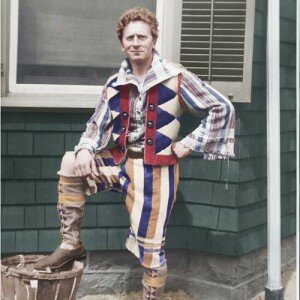“amazing skill, personality and vigor” – Harold C Schonberg

Grainger in one of his toweling outfits
© Percy Grainger Museum, Melbourne
Gershwin: Love Walked In (arr. P. Grainger)

Percy Grainger
© Percy Grainger Museum, Melbourne
Grainger: Molly on the Shore
He was a noted eccentric, with a penchant for colourful outfits which he made himself out of towels. He was also known to dash across the stage, wearing only gym kit, and leap on to the piano stool, or, at the end of the Grieg Piano Concerto after finishing the final cadenza, he would run through the audience, touch the back wall of the auditorium and rush back onstage in time for the final chords of the concerto. His predilection for unusual sexual practices is also well-documented and the Percy Grainger Museum in Melbourne contains a collection of his whips, including some made from old conductors’ batons.
Grainger: Blithe Bells (arr. of J.S. Bach’s Sheep may safely graze for piano)
Most of his works are miniatures, and often feature unusual instruments such as the theremin or banjo. He was ahead of his time, musically, and experimented with flexible rhythms, improvisations, tuned percussion, influences from jazz and world music, microtones and chance processes and even electronics before John Cage was even born. He invented instruments of his own, including the Kangaroo Pouch, an oscillator which sounded like a malfunctioning air-raid siren, and the Butterfly piano, tuned in 1/6 tones.
Grainger: Country Gardens
He eschewed traditional Italian musical terms, preferring his own such as “louden lots” for crescendo, and coined new tempo markings like “clingingly” or “hammeringly”. He rejected his German conservatoire training and disdained classical form, so you won’t find any symphonies or sonatas amongst his oeuvre. But what you will find are free-form instrumental fantasies, deeply evocative choral settings, and improvisatory “rambles”. His music is overflowingly romantic, rich in ingenious, idiosyncratically lush harmonies, pungent dissonances and perfumed resolutions, ardent long-spun melodies and impractical yet elegant rhythms. Too often regarded as a composer of “light music”, perhaps because of his fondness for folksongs, his music is in fact sophisticated, always engaging and accessible, and with a delightful dash of wit.

Love Percy’s music. I’ve been to his museum in Melbourne; fascinating place.